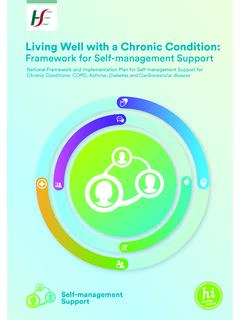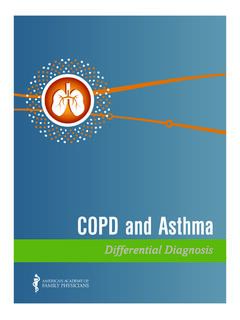Transcription of Nursing Management of COPD - The Nursiversity
1 Nursing Management of copd chronic obstructive pulmonary disease ( copd ) is a disease of the lung characterized by emphysema and/or chronic bronchitis. Emphysema affects the small airways and alveoli, while chronic bronchitis affects the bronchi and bronchioles. Emphysema In emphysema the lung loses elasticity and becomes hyperinflated causing dyspnea and an increased respiratory rate. Patho: Increased amount of proteases cause damage to the alveoli and small airways by degrading elastin. The alveolar sacs lose their elasticity, and the small airways collapse or narrow. Air begins to become trapped in the lung. The hyperinflated lung leads to flattening of the diaphragm which weakens the effect of the muscle. This causes the patient to use accessory muscles while breathing, which causes them to have to work harder to breathe. This leads to carbon dioxide retention, chronic respiratory acidosis, and decreased arterial oxygen.
2 Emphysema can be panlobular, centrilobular, or paraseptal. It is associated with smoking or chronic exposure to irritating inhalants chronic Bronchitis chronic bronchitis is characterized by inflammation of the bronchi and bronchioles. It is caused by exposure to an irritant- usually cigarette smoke. This chronic exposure leads to inflammation, vasodilation, mucosal edema, congestion, and bronchospasm. The large amount of thick mucus is caused by the increased amount and size of mucosal glands. The excess mucus is a breeding ground for bacteria, so individuals with chronic bronchitis often suffer from acute lung infections. Over time the bronchial walls thicken which causes reduced air flow. The physiological changes in chronic bronchitis results in hypoxemia and respiratory acidosis. Risk factors for copd Smoking Second-hand smoking Alpha1-antitrypsin deficiency Complications from copd copd affects oxygenation of all tissues.
3 Hypoxemia and acidosis lead to reduced gas exchange. Hypoxemia & acidosis- leads to reduced oxygenation and increased carbon dioxide levels Respiratory infection- acute lung infections make copd worse. The infections are accompanied by even more inflammation and mucus on top of the existing inflammation and mucus. This causes increased incidence of bronchospasm. Cardiac failure (cor pulmonale)- right sided heart failure caused by pulmonary disease . Increased lung pressure causes increased workload of the right side of the heart. This results in backflow into the general venous system. Signs & Symptoms: Dyspnea Cough Unplanned weight loss results from the increased need for calories due to the patient working so hard to breathe. Patients often don't have the energy to make meals or will not be able to finish eating a meal due to dyspnea or persistent coughing. Stooped posture Tripod positioning- patients use this position to help alleviate dyspnea Abnormal breathing pattern- use of accessory muscles- due to the weakening of the diaphragm, the patient must use accessory muscles during breathing Wheezing, diminished breath sounds barrel chest results from chronic hyperinflation of the lungs Cyanotic, dusky appearance due to decreased oxygenation of tissues Excessive sputum production due to increased amount and size mucosal glands Finger clubbing Decrease capillary refill due to decreased oxygenation of tissues Labs: - chronic respiratory acidosis>>metabolic alkalosis - Polycythemia Treatment: The focus is on long-term control therapy with longer-acting medications.
4 - Beta-adrenergic (albuterol) - Cholinergic antagonists (ipratropium) - Xanthines (theophylline) - Corticosteroids (fluticasone, prednisone) - Cromones (nedocromil) - Mucolytics (acetylcysteine) Lung reduction surgery Nursing interventions: Airway maintenance- most important to improve gas exchange - Monitor the patient for changes in respiratory status every 2 hours while hospitalized - Teach the patient how to utilize diaphragmatic or abdominal and pursed-lip breathing during periods of dyspnea - Position the patient upright in the bed with the head of the bed elevated - Teach the patient to cough upon waking up in the morning, before mealtimes, and before bedtime - Monitor the consistency, color, odor, and amount of sputum produced - Utilize 2-4 L of oxygen per nasal cannula as needed and as prescribed - Suction secretions in severe cases - Encourage the patient to drink 2-3 L of fluid per day - Encourage the patient to eat high-calorie, high-protein foods Nursing Care Plan for copd In this section, we will review potential Nursing diagnoses and associated Nursing interventions for patients with copd .
5 The examples given are based upon what a typical patient with copd might look like. Be sure that when you are creating your Nursing care plans that you individualize the Nursing diagnoses and the as evidenced by to your patient. If you have any further questions about Nursing care plans, you can check out my in-depth post about Nursing care plans here. Nursing Diagnoses for copd Activity Intolerance Ineffective Airway Clearance Anxiety Death Anxiety Interrupted Family Processes Impaired Gas Exchange Ineffective self -Health Management Imbalanced Nutrition Powerlessness self -Care Deficit chronic Low self -Esteem Sleep Deprivation Impaired Social Interaction chronic Sorrow Risk for Infection Readiness for Enhanced self -Health Management Ineffective Airway Clearance r/t excessive mucus, thickening of bronchial walls AEB persistent cough with excess thick sputum production, dyspnea, restlessness Goal: Airway Patency AEB respiratory rate between 10-20 breaths per minute, productive cough with thin, easy to produce sputum, absence of restlessness Nursing interventions.
6 - The nurse will monitor respiratory patterns (rate, depth, and effort) every 2 hours (to identify if the airway is improving or declining) - The nurse will position the head of the bed at 45 degrees (to maximize lung expansion) - The nurse will assist the patient in controlled breathing and coughing. The nurse can recommend the use of the huff cough (to help the patient effectively clear secretions) - The nurse will encourage the patient to drink 2-3 L of fluid daily (to help thin the secretions and make them easier to clear) - The nurse will administer prescribed medications such as bronchodilators, mucolytics, corticosteroids (to help open the airways and make the secretions easier to clear) - The nurse will observe sputum when it is produced- note the color, amount, and odor (to identify normal vs abnormal sputum) Activity Intolerance r/t imbalance between oxygen supply and demand AEB tachypnea and dyspnea upon performing simple activities, patient becomes short of breath during seated conversation, patient takes frequent breaks to catch her breath during conversation, patient has been refusing a bath because she says she becomes exhausted after bathing Goal.
7 Activity Tolerance AEB breath rate between 10-20 respirations during activity, oxygen saturation remains above 90% during activity, patient does not report getting tired quickly during activities of daily living anymore Nursing interventions: - The nurse will encourage the patient to rest and conserve their energy (to prevent exacerbations of dyspnea) - The nurse will encourage the patient to use pursed-lip breathing during breathlessness that occurs during activity (to help decrease the severity of dyspnea and offer the patient a sense of control) - The nurse will encourage the use of the tripod position during episodes of breathlessness that occurs during activity (to help facilitate easier breathing and better oxygenation) - The nurse will monitor the patient s respiratory response (rate, rhythm, depth) during activity (to assess for worsening or improvement of activity intolerance) - The nurse will provide the patient with the prescribed amount of oxygen therapy during activity and continue to monitor the patient s oxygen saturation throughout the activity (to ensure adequate oxygenation) Imbalanced Nutrition.
8 Less than body requirements r/t decreased intake because of dyspnea AEB patient has lost 15 pounds in the past several months, patient has a BMI of , patient states she barely eats throughout the day, patient states she does not have the energy to cook herself food and that it is too much of a hassle Goal: Balanced Nutrition AEB patient maintains current weight or returns to previous weight, patient maintains a BMI of greater than , patient will eat high-calorie and high-protein foods throughout the day Nursing interventions: - The nurse will monitor food intake and record percentages of food eaten for each meal (25%, 50%, 75%, 100%) (to identify patterns of eating) - The nurse will encourage the patient to eat high-calorie and high-protein foods (to ensure adequate nutrition even if the patient doesn t eat frequently throughout the day) - The nurse will encourage the patient to eat small, frequent meals as opposed to less frequent, large meals (to reduce the risk of a meal not being finished due to breathlessness or exhaustion) - The nurse will encourage the patient to practice effective coughing before mealtimes (to clear the airways for more pleasant mealtimes and to prevent the mealtime from being interrupted by the need to cough up sputum) - The nurse will collaborate with the case manager or social worker to assess if the patient would be appropriate for a meal assistance program (such as Meals on Wheels)
9 Upon return to the home (this ensures the patient will receive meals and will not miss out on meals due to inability to cook them) NCLEX Style Questions for copd Which of the following Nursing diagnoses should be the nurse s priority for a patient who is experiencing a copd exacerbation? A. Powerlessness B. Impaired Gas Exchange C. Imbalanced Nutrition D. Anxiety A community health nurse is giving a presentation to a group of individuals about copd . She needs to include the risk factors for copd . Which of the following should she include in her presentation? A. Poor diet B. Diabetes C. Smoking D. Drug abuse A nurse is educating a newly diagnosed patient with copd . Which of the following dietary guidelines should the nurse include in the teaching? (Select All That Apply) A. The patient should eat 3 large meals during the day B. The patient should drink 2-3 L of fluid per day C. The patient should perform coughing techniques before each meal D.
10 The patient should follow a low calorie, high fat diet E. The patient should avoid meal replacement drinks such as Ensure








